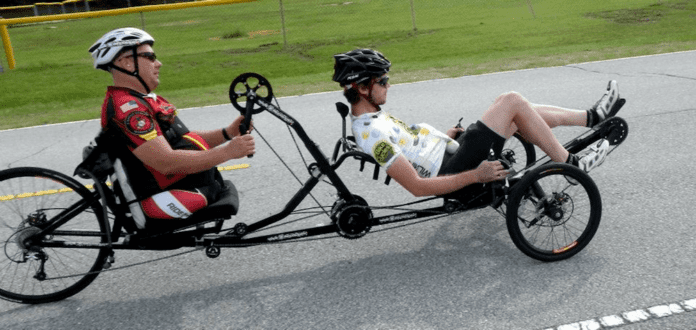The bicycle dates back to 1418, according to LiveScience.com, when engineer Giovanni Fontana constructed a four-wheeled human-powered device. Today, bicycles are used for a number of reasons, such as transportation, therapy, leisure recreation and competitive sport. Today, adaptive bicycles make cycling accessible for riders with disabilities.
Benefits of Adaptive Bicycles
Jarrod Cooper, who owns a mobile bike shop called Velofix, uses his special bicycle-built-for-two as a fundraising tool. He and his son, Jacob, who has Down syndrome and autism, ride a buddy bike in campaign events, like the American Diabetes Association’s Tour De Cure. “It’s a tandem bicycle specifically made for riders with special needs who have another rider there to assist them,” describes Jarrod, who crowd-sourced to cover the cost of the bike. The pair began riding around their neighborhood and now complete 20-25 mile rides, impacting both their well-being and the greater good of nonprofit missions.
For riders with disabilities, adaptive bicycles can boost physical benefits, such as increased joint motion, muscle movement, circulation, core development, coordination and balance. And for emotional gains, adaptive bikes can help foster inclusion and a sense of independence, among other benefits.
According to Wheels for Well-being, a British organization championing cycling for disabled riders, the majority of disabled cyclists (69%) who participated in a survey said they find cycling to be more comfortable than walking, because of eased joint strain, balance and breathing. The organization hopes adaptive cycles will become more respected as mobility aids, similar to that of wheelchairs and scooters.
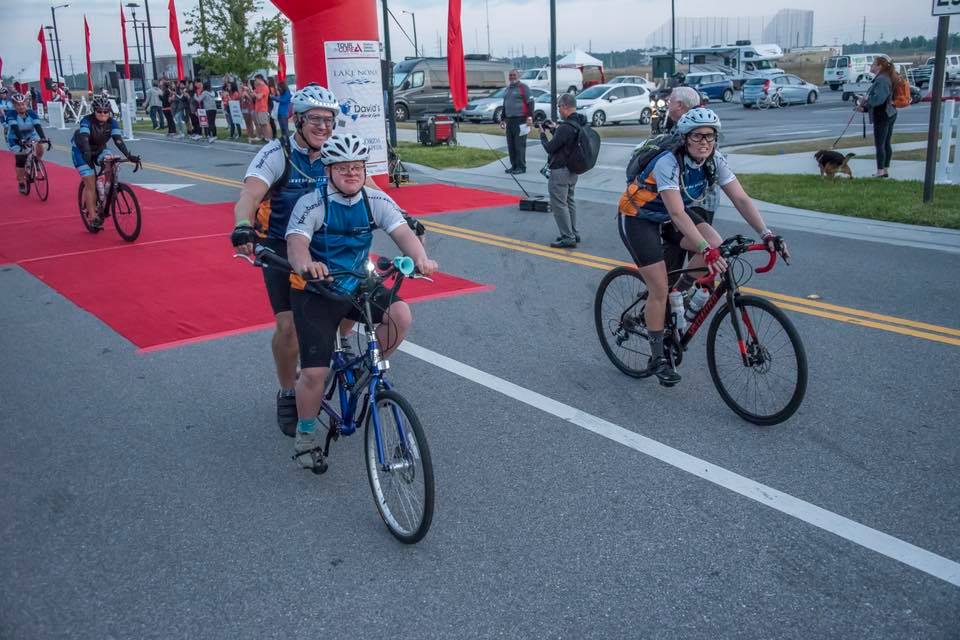
Types of Adaptive Bicycles
Because riders have varying abilities, there are many different variations of adaptive cycles. Disabled Sports USA defines the following examples:
- Handcycles are popular among riders with lower-limb mobility impairments. They allow cyclists to propel a three-wheeled cycle using their arms.
- Tandem bikes are available in a variety of setups with the most common being a two-wheeled bike with a guide in the front. A side-by-side tandem tricycle allows two people to cycle simultaneously or at different rates.
- Four-wheeled dual recumbents keep riders in a relaxed, seated position and are best for lower-extremity cycling.
- Three-wheeled recumbent cycles are lower to the ground which creates a lower center of balance.
- A recumbent foot cycle comes in a tadpole style — one wheel in back and two in front. The tadpole style is better for balancing. A recumbent foot cycle also comes in a delta style — two wheels in the back and one in the front.
- A recumbent handcycle sits higher off the ground. It is easier to transfer to and would be used by someone who has less mobility. There are also handcycles much lower to the ground that are more efficient for competitive cycling.
Electric bikes, also known as e-bikes, are fairly new to the cycling scene but they’re definitely here for the long-haul. An e-bike offers a motor-assisted ride which is excellent for riders who prefer to lessen the demand of pedaling. Plus, powered cycles allow riders of all abilities to cover more miles. Check out reviews of popular e-bikes here. And for other adaptive bicycles and gear, find lists compiled by especialneeds.com and friendshipcircle.org.
Organizations Leading the Pack
Charlie’s Champs
As a neurodevelopmental pediatric physical therapist, Allie Benson has plenty of experience assisting children with special needs. During her first pregnancy, Allie and her husband, John, learned their daughter, Charlie, had multiple heart complications and omphalocele, a birth defect where organs grow outside of the belly. Sadly, Charlie died in utero but her impact lives on. In 2018, the Bensons founded Charlie’s Champs, a nonprofit focused on gifting adaptive bicycles to children.
Allie’s professional training helped steer her decision to honor her daughter and children like her. “I am really passionate about giving kids with special needs access to mobility. Insurance typically covers the necessities like wheelchairs, standers and gait trainers; but it rarely, if ever, covers recreational equipment likes bikes,” she tells AmeriDisability, adding, “For many of these kids, biking is one of the few ways they can participate in play with their siblings and friends. Bikes can be adapted so that kids of all abilities can keep up with each other.”
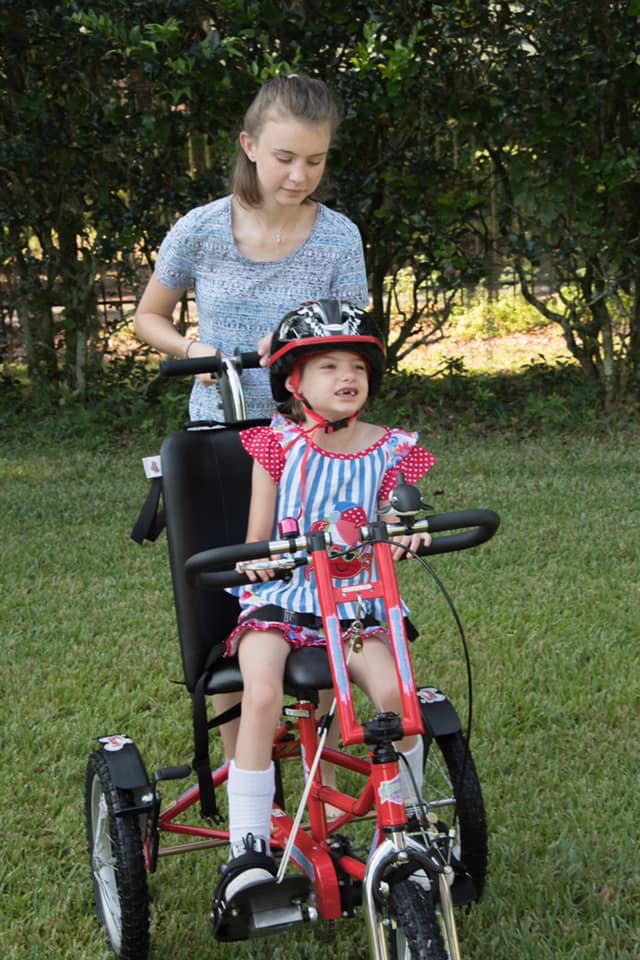
Amanda Lyon, a mother of three, can attest that her daughter’s adaptive bike fosters inclusion. Six-year-old Samantha was diagnosed with Hypoxic Ischemic Encephalopathy (HIE) at birth, a type of brain damage that occurs when the brain doesn’t receive enough oxygen and blood. She was also diagnosed with cerebral palsy three years later. Since infancy, Samantha has attended continual sessions of physical therapy, occupational therapy, aqua therapy and speech therapy – all of which have contributed to significant gains. “Early interventions on a regular basis have allowed Samantha to rebuild neural networks around the original brain damage that occurred from a lack of oxygen at birth,” Amanda says. She casually mentioned during a therapy session that she wished Samantha had access to an adaptive bicycle at home for continued muscle development… and that statement was all it took to get the wheels in motion! Amanda learned that Samantha’s former therapist, Allie, could make it happen and, soon thereafter, Samantha received her very own adaptive bicycle courtesy of Charlie’s Champs.
“Although we had [previously] purchased several trikes, she was never able to actually use them. She would slip off the seat or be unable to keep her feet on the pedals,” Amanda explains. The bicycle from Charlie’s Champs was customized to work for Samantha’s body and skill level. “It has a full seat, straps, buckles, adaptive handlebars and a pulley system that allows for reciprocal pedaling,” describes Amanda.
Samantha likes music, swimming and strawberries but she especially loves her new bike! And Amanda believes the benefits are definitely both physical and emotional. “This adaptive bike will allow her to explore the neighborhood and make friends with others while at the same time building muscle strength she needs for walking,” she says. And that’s all the reason the Bensons need to keep fundraising for the cause. “Charlie was never able to bike, but she inspired us to provide lots of other kids with the opportunity to,” Allie says. Based in St. Petersburg, Florida, Charlie’s Champs is now customizing its tenth bicycle to be donated. John adds, “In addition to the adaptive bikes, we also run a free durable equipment exchange [Charlie’s Closet] for special needs kids and their families. We are providing a way for families with equipment they don’t need anymore to connect with families that do. That includes wheelchairs, walkers, assistive standers, etc.”
Adaptive Cycling Foundation
With more than 28 professional years in the cycling industry, Scotty Moro describes himself as a “professional mechanic, longtime competitive cyclist and all around cycling geek.” Through engaging with military-serving nonprofits, Scotty explains that he and his wife, Lisa, recognized their “life’s purpose” with the realization that service members open up to each other while riding. “The unique peer-to-peer therapy it provides is unmatched in its ability to positively affect all aspects of those experiencing post-traumatic stress, depression, anxiety, mobility restrictions and so on,” he says.
In 2016, Scotty added another title to his resume (nonprofit founder) with the establishment of the Adaptive Cycling Foundation, an organization that supplies and manufactures adapted bikes for wounded service members and first responders. Scotty combines his cycling and mechanic expertise to create specialty adapted bikes for injured heroes and grant the “healing power of cycling.” Based in Mechanicsburg, Ohio, the Adaptive Cycling Foundation has aligned with Quality of Life Plus (QL+), an innovative assistive device developer, on a voice-activated gear shifting system for handcycles.
Thanks to the generosity of foundation donors who have made adaptive cycling possible, Scotty says he’s witnessed heroes reduce their medication use, control suicidal thoughts, repair family relationships and proactively pursue employment opportunities.
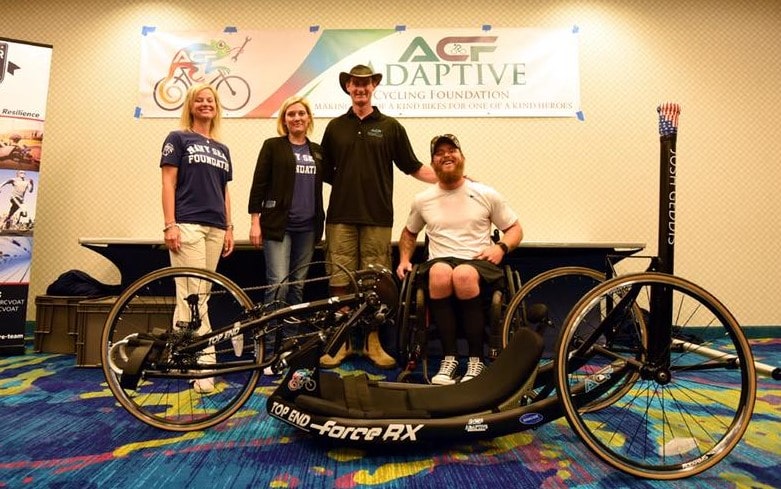
Cycling Without Age
Ole Kassow explains that he wanted to help seniors feel a part of society. In 2012, his rickshaw-style pushbike initiative, Cycling Without Age, launched to grant seniors the sensation of “wind in their hair” and experience the city and nature around them regardless of mobility limitations. Today, the Denmark based effort is in more than 40 countries, including the United States (with 125 active chapters nationwide).
“Our front-passenger ‘trishaws’ are specially adapted to accommodate physically-challenged passengers,” says Kelly D. Talcott, U.S. Captain for Cycling Without Age. While styles vary, the effort primarily uses front-passenger trishaws, a padded two-seater compartment with weather-proof blankets and the pilot pedaling in the back. “When people are sitting in a trishaw, they are presented as people sitting in a place of honor ─ up front ─ in a unique vehicle that encourages interaction,” Kelly declares.
Cycling Without Age has been praised for its community collaborations, including programs with nursing homes, advocacy groups, cycle clubs and others. To find or start a chapter, visit CyclingWithoutAge.org.
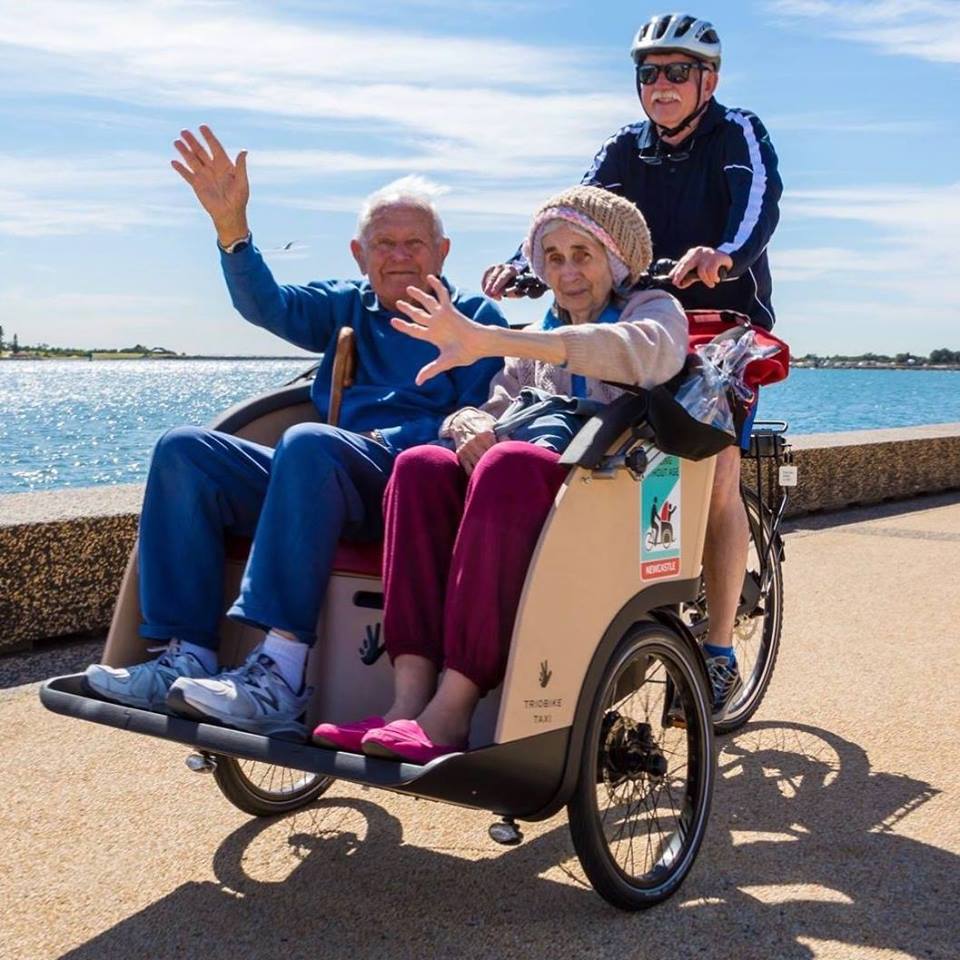
Bike Share Programs
Many cities throughout the U.S. have implemented bike share systems, where users can rent and return bicycles from public racks, known as docks. Many systems do not include adaptive cycles; however, some systems do, as in Portland and Detroit.
Launched in 2017 in Minneapolis, Minnesota, Twin Cities Adaptive Cycling (TCAC) is a nonprofit bike share for youth and adults with disabilities. “Our program has a fleet of 40 adaptive bikes, including handcycles, recumbent foot trikes, therapeutic trikes and various styles of tandems,” says Caito Bowles-Roth, co-founder and executive director of TCAC. This program provides customized adaptive bicycle fittings and low-cost regular use of bicycles and equipment, in addition to comprehensive training and opportunities to participate in group rides.
Caito says the program proved to be successful almost immediately. “In 2017, we introduced adaptive cycling to 40 individuals and, in 2018, that number grew to 120 individuals. We currently average about 18 riders a day, and we expect to see that number continue to grow this season,” she says.
Caito says that two other adaptive bike programs and/or rentals operate in the surrounding area, and she hopes other communities across the country will also answer the demand for adaptive systems. “Talk with your local community programs and policy-makers about the importance of making sure bike share programs are accessible to everyone,” she offers. For helpful resources, read these tips from bike share provider Zagster.
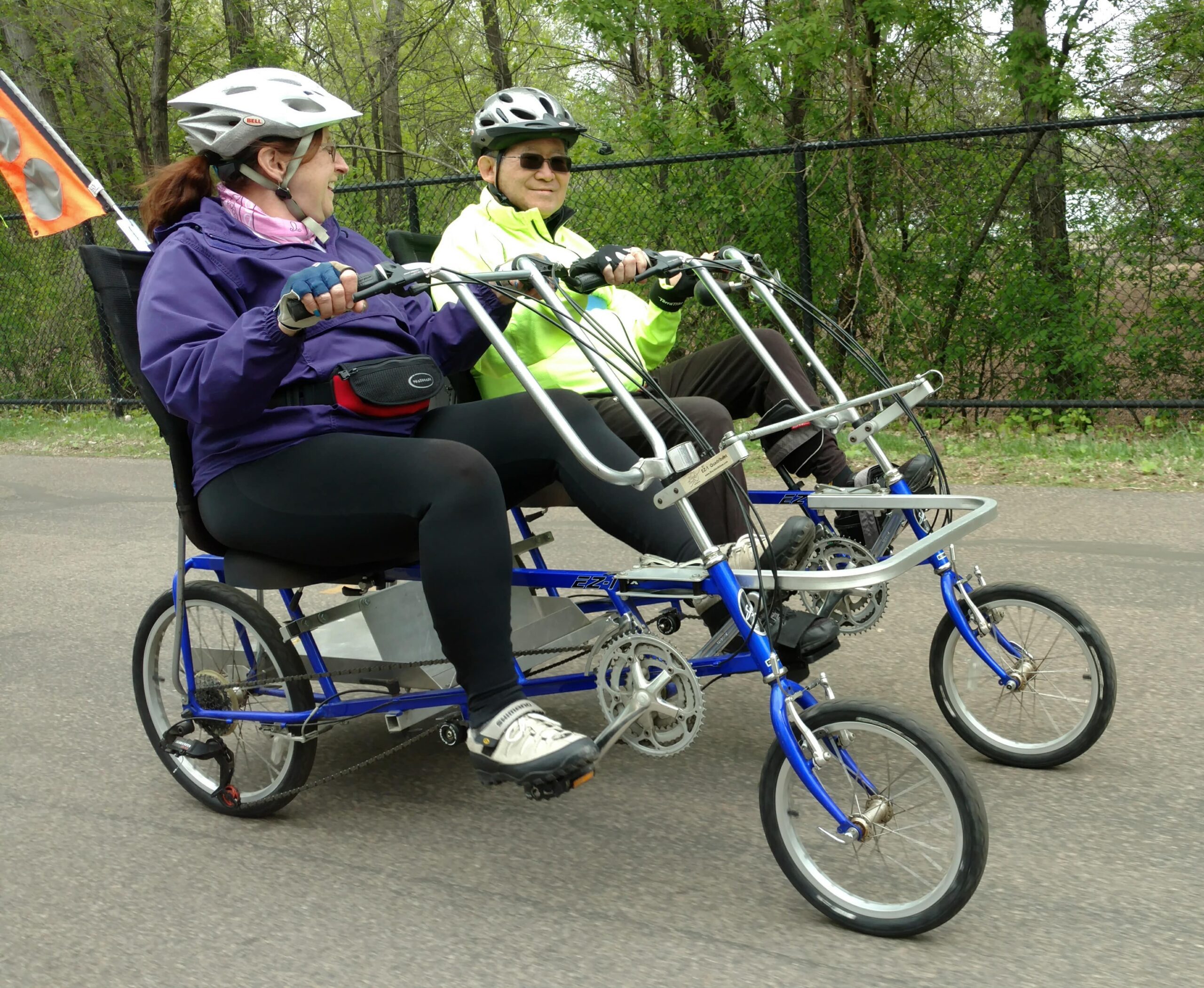
Feature image credit: Adaptive Cycling Foundation




